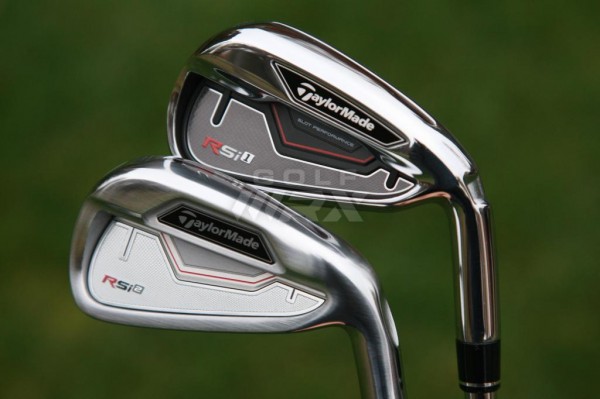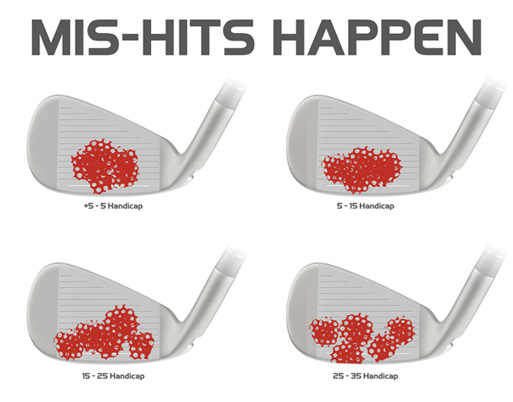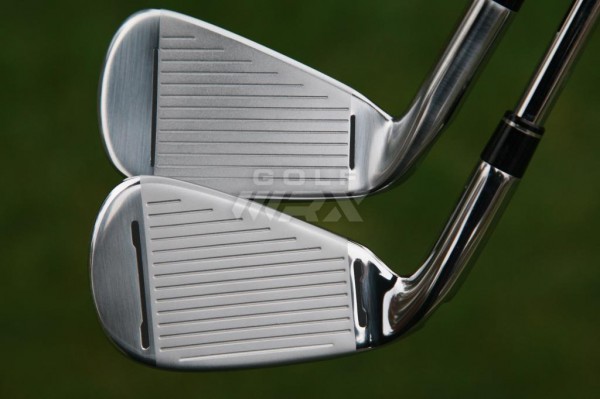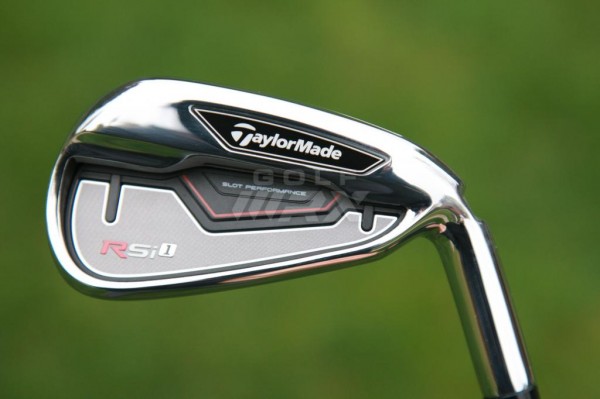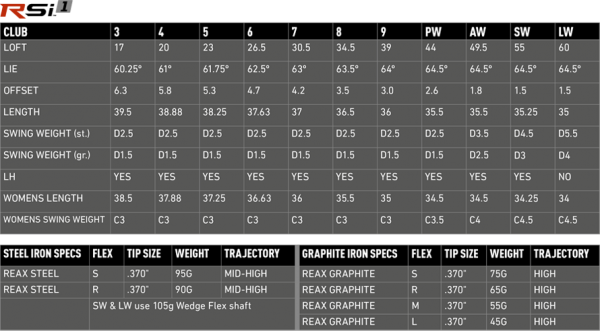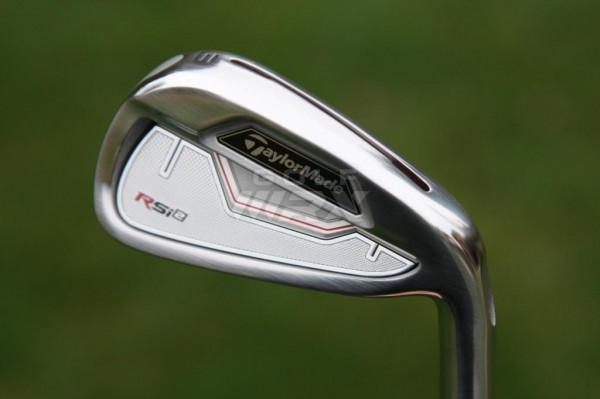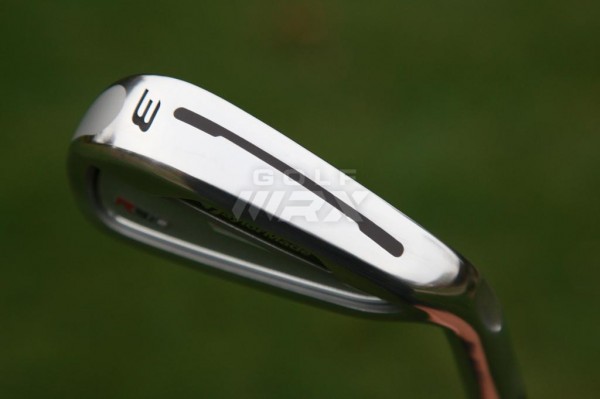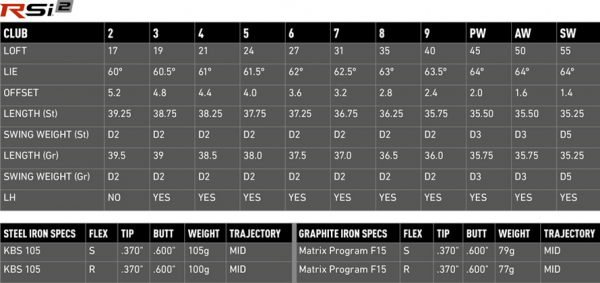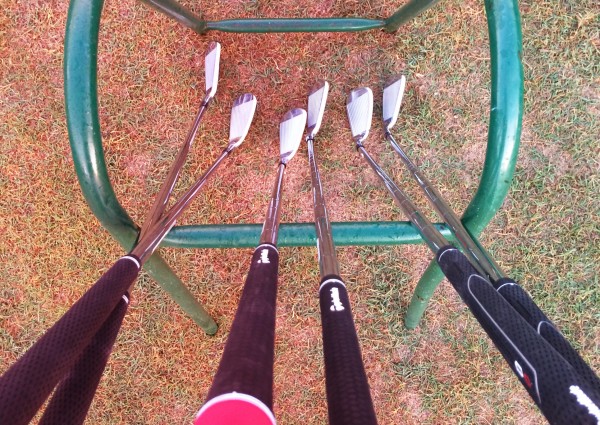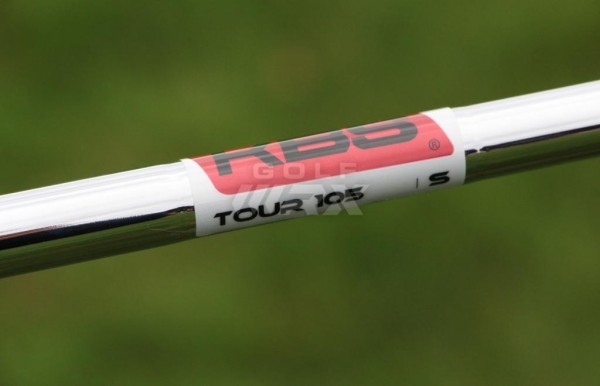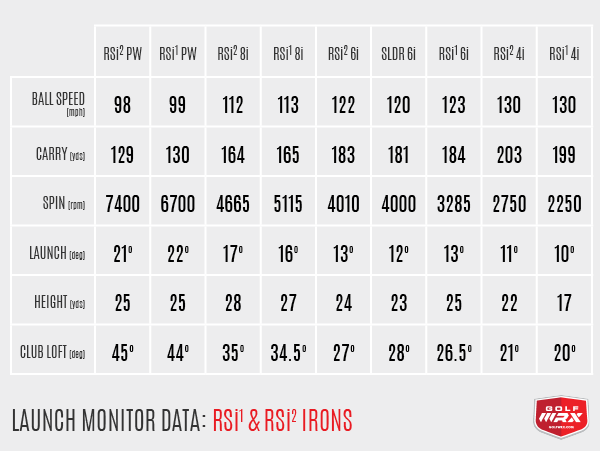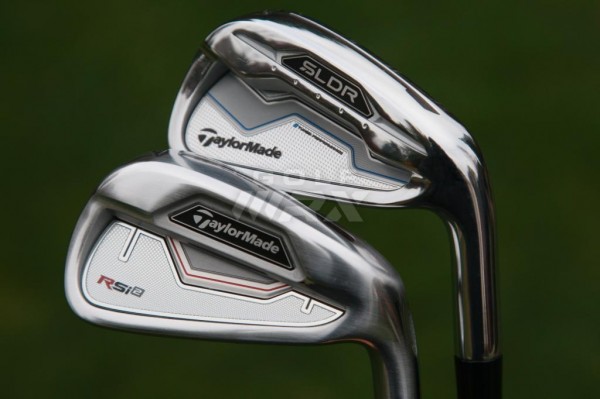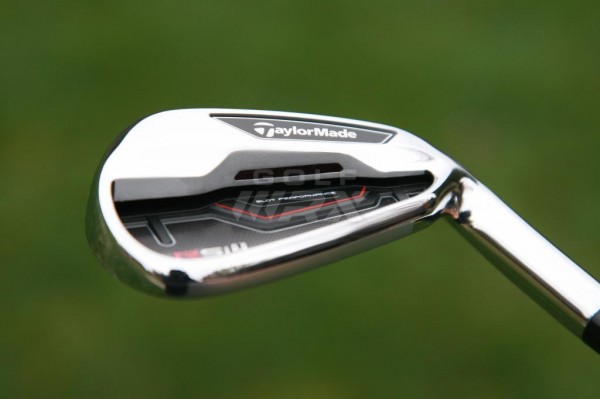Pros: The RSi 1’s offer big distance from almost anywhere on the face. The more compact RSi 2’s are top performers that surprised us with their improved feel, and their progressive design will work for a wide range of players.
Cons: The RSi 1 and RSi 2’s are a bit better than their predecessors — SpeedBlade and SLDR, respectively — but that’s probably not enough for most players to upgrade.
Who are they for? Golfers looking for more distance and forgiveness. Put these on your list of irons to test if you’re in the market for new irons.
Overview
For once, I get to start a review writing something other than “these clubs will be crazy long!” Instead, with the RSi 1 and RSi 2 irons, TaylorMade focused on forgiveness. So while the new RSi irons will be just as long if not slightly longer than their predecessors — TaylorMade’s SpeedBlade and SLDR irons — the new irons focus on creating more distance on mishits, not on center hits.
Both iron sets employ TaylorMade’s Speed Pocket in the 3-7 irons, which is a slot in the sole that is designed to produce longer, higher-flying shots, especially on mishits low on the face. It works like this — a polymer-filled slot in the sole makes the bottom of the irons more flexible, which helps shot hit on the bottom of the clubface launch higher, faster and with less spin.
So what about shots hit on the heel and toe? That’s where TaylorMade’s new Face Slot technology comes in.
Face Slot Technology
The new Face Slot Technology, which is included in the 3-8 irons of each set, is like Speed Pockets for the heel and toe areas of the club. When mishits happen there, the slots allow the face to more easily. That, in theory, will help generate more ball speed on mishits than previous TaylorMade irons.
RSi 1 Irons
The RSi 1 irons are the largest and most forgiving of the three irons in the RSi family. Aimed squarely at the higher handicap golfer looking for maximum forgiveness, their Face Slots, Speed Pockets and thin faces help deliver consistent ball speeds all over the face. The 3-7 irons are cast from 450 stainless steel and the 8-iron through AW are cast from 17-4 stainless steel.
RSi 1 Specs
[wrx_buy_now oemlink=”http://taylormadegolf.com/RSi-1-Irons/DW-WZ134.html” oemtext=”Learn more from TaylorMade” amazonlink=”http://www.amazon.com/gp/product/B00OISPX6G/ref=as_li_qf_sp_asin_il_tl?ie=UTF8&camp=1789&creative=9325&creativeASIN=B00OISPX6G&linkCode=as2&tag=golfwrxcom-20&linkId=36NGBZXZJUS4EVN3″]
RSi 2 Irons
The RSi 2 irons are aimed at better players looking for a more traditional shape, sound and feel. They’re TaylorMade’s most progressive set when it comes to materials and construction. The 3-AW contain five different constructions to maximize feel, distance, sound and consistency.
Tungsten has been added low in the toe of the 3-5 irons for added forgiveness. The 6-7 irons are cast from 450 stainless steel, and the 8-PW are cast from 431 stainless steel, but with the added feel benefit of a forged 1025 carbon steel face insert. To round out the set, the AW and SW are fully-forged from 1025 carbon steel.
RSi 2 Specs
[wrx_buy_now oemlink=”http://taylormadegolf.com/RSi-2-Irons/DW-WZ218.html#start=2″ oemtext=”Learn more from TaylorMade” amazonlink=”http://www.amazon.com/gp/product/B00OIT8JXY/ref=as_li_qf_sp_asin_il_tl?ie=UTF8&camp=1789&creative=9325&creativeASIN=B00OIT8JXY&linkCode=as2&tag=golfwrxcom-20&linkId=RT3C33DRNXFWPHH5″]
The RSi 1 irons are available in 3-PW ($799), 4-PW ($699), and 4-PW, AW ($799). The stock steel shaft is the new True Temper Reax 90, which will produce a slightly flatter trajectory than the Speedblade stock shaft.
The RSi 2 irons are available in 4-PW ($874.99) and 4-PW, AW ($999). The stock steel shaft is the KBS Tour 105 available in R and S flexes. Custom shaft and grip options are available.
Both sets were released on November 14, 2014.
Performance: Driving Range & Course
As with all the club testing I do, I like to first get outside and test the clubs at the driving range during calm conditions, just to get a feel for the clubs.
Because I was interested in how the forged face insert of the PW would feel and perform, I started the testing with that club. Unlike the SLDR irons, which took a full range session to warm up to, I was instantly in love with the RSi 2 irons. I mean right after the first ball came off the face. The feel and sound was incredible and the ball flight had a nice tight draw with good height. The forged insert really made the entire club feel almost completely forged. The 8 and 9 irons also have the forged face, so I hit those two clubs next with the same result. Super soft feel with plenty of feedback.
My distances all looked spot on. I wasn’t hitting these clubs any further than I expected and there weren’t any hot spots on the face. Moving down into the mid and long irons, where the face slots come into play, I was curious how mishits would feel. These aren’t magic clubs, so mishits are mishits, but I did notice that my shots off the toe and especially the heel still got up in the air and they weren’t as likely to spray sideways.
I really liked the KBS Tour 105 shaft. It was much more similar to the True Temper Dynamic Gold S300 shafts that I have been gaming the last few years. There was a sturdiness to it, without feeling heavy. I felt like I could go after shots much more than I could with the stock KBS C-Taper 90 of the SLDR.
On the Course
I played Bear’s Best in Atlanta with my brother Casey, a track that makes you think about where you want to land the ball, especially on greens which were fast and undulating. Casey is a typical weekend golfer who would be a perfect fit for the RSi 1 irons, so I was interested to see how he hit them.
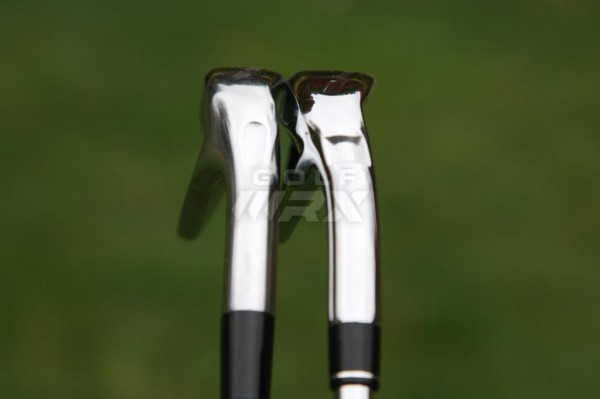
Above: TaylorMade’s RSi 2 irons (left) have narrower soles, shorter blade lengths and less offset than the RSi 1 irons.
The performance of the RSi 2 irons on the course was nothing short of fantastic. I’m not exaggerating or trying to play these irons up. I hit some stunning approach shots with the irons, especially anything 6 iron and shorter. By the middle of the round, I started to lay shots back so I could hit a variety of different irons. The entire set has a nice baby draw to it. Nothing crazy and I could work the ball to the right, too, but I was consistently hitting a nice tight draw with these clubs.
We all have a shot we remember and mine was a 9 iron from 145 to a back pin on an elevated green. It started to get a little windy so I wanted to keep the ball down and played a boring, tight draw that hit, checked and stopped within feet of the pin. It was a designed shot that executed perfectly. If I wasn’t already sold on putting these in the bag, I was after that shot.
I mentioned I wanted Casey to play some shots with the RSi 1 irons. I brought a PW and 7-iron and asked him to hit those instead of his Cobra S3 irons. He sometimes has a problem getting height out of his irons and his tendency is to miss right with a cut. His best shots of the day came with the RSi 1 irons. He used the 7 iron from a variety of different lies and each time was able to get the ball up with more distance, height and accuracy than his current set.
I checked out the impact marks from some of the shots out of the rough and could see that he wasn’t hitting the dead center of the face, but the shots still looked and performed like good golf shots. While we might only be talking about a few shots during a round, it was important to see how the RSi 1 irons performed for a player squarely in their target market.
Performance: Launch Monitor
The next step was to get on a launch monitor and to get some real numbers and see how ball speeds were affected on mishits. Because I was testing two sets and wanted to do all the testing during one session, I tested the PW, 8-iron, 6-iron, and 4-iron in each set. I threw out true mishits and also looked at ball speed on shots off the toe and heel, as well as high and low on the face. My goal was to simply see if the ball flight matched TaylorMade’s claims. All the clubs were tested on the same launch monitor with the same type of balls. I also tested the SLDR 6 iron during the same session for a direct comparison.
After seeing the shots on the range and the course, I expected to see that my distances were all inline with what I was seeing on the course and they were. The average ball speed, launch angle, spin, and peak height were all right in the range I hoped to see with the RSi 2.
Comparing the two sets together, there were some differences. Across the board, the RSi 1 irons, with the larger heads and more forgiveness, generated an average of 1 mph more ball speed and 1 yard more carry. The spin generated by the RSi 1 irons was generally less for every club except the 8 iron. Interestingly, the launch angle for the RSi 1 irons was lower for me than the RSi 2 irons, as was the peak height. We’re talking about no more than a degree or two of launch and a yard or two of peak height. Although both sets are designed to have a flatter trajectory than the SpeedBlade or SLDR irons, I expected to see balls getting up in the air more with the RSi 1 versus the RSi 2 irons.
Forgiveness on Mishits
In addition to this review, Tom Stickney as a great piece where he compares the results of solid to unsolid hits with the RSi 2 and also includes dispersion charts from Trackman. I would recommend you check it out as well.
For my swing and testing, the results turned out to be very similar. Shots off the heel of the RSi 2 6 iron produced ball speeds an average of 5 mph slower than shots off the middle of the face. Shots off the toe produced speeds an average of 4 mph slower than off the center. The dispersion of all of the shots stayed within a 7-mph range for all unsolid, center shots. Most importantly, the direction of the shots was not affected as much on mishits. My offline dispersion was relatively tight, staying within a 15-yard range side to side. That is enough to keep me in the fairway with long irons and close to or on the green with approach shots.
Comparison to SLDR
One thing we strive for when writing reviews at GolfWRX is to be as unbiased and transparent as we can. The reality is that technology has come a long way and we get a chance to review the very best. The RSi irons are no exception. Many of you are probably wondering how these stack up against the SLDR irons that were just released this summer. Well, if a buddy of mine gaming the SLDR irons asked me if he should switch to the RSi 2 irons, I would say unless he has money to throw around or just likes to have the latest gear in his bag, he should stick with what he has. The SLDR’s are still an excellent set. I’ve hit beautiful shots and played great golf with them. If a buddy is going out looking for a set to replace one from a few years back, however, I’d send him straight over to hit the RSi 2.
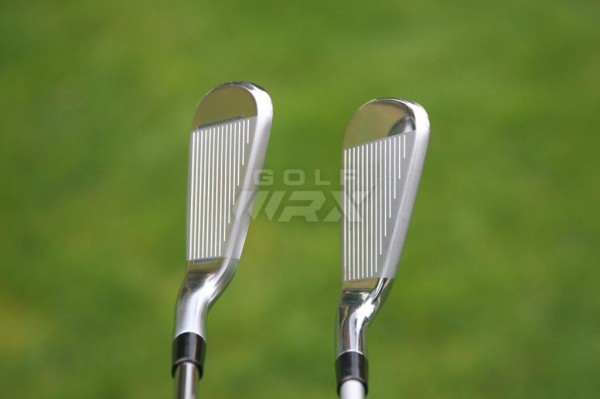
A Tale of Two 7 irons: TaylorMade’s RSi 2 (left) and SLDR irons.
It is true that I’m playing better golf so far with the RSi 2 irons, but the differences are really, really close. The trajectory is noticeably flatter than with the SLDR irons. Some of this can be attributed to the difference in the KBS C-Taper 90 in the SLDR and the slightly heavier KBS Tour 105 in the RSi 2. Mishits off the toe and heel are only separated by an average of 1 mph of ball speed and 2 yards of carry. Even the peak height, spin and launch are all very close, but numbers aren’t everything. What I’ve seen on the course is that my misses are more playable, the feel is softer and the sound is better than with the SLDRs. All this adds up to a belief that the RSi 2 irons are better for me, and that likely plays a big role in scoring well.
That said, we’re getting close to the holidays and if someone wraps up a set of SLDR irons for you, put them in the bag and know that you are going to love them.
Looks & Feel
Let’s start by talking about the RSi 2. When I reviewed the SLDR irons earlier this year, I complimented TaylorMade on moving away from the flashy colors and sporty look of the RocketBladez and SpeedBlades of the past and toward a more traditional, understated and “tour-like” look. It is clear the RSi 2 irons are the SLDR’s better looking younger brother. Every line on the club has a subtle roundness and smoothness to it. The colors all blend nicely, and the steel is more matte and less shiny polished chrome. The “Forged” stamp on the 8-PW, while somewhat misleading, does lead you into believing, even for a second, that you have a fully-forged club in your hand. Even the RSi 2 logo is small and the only edgy component to the entire design package.
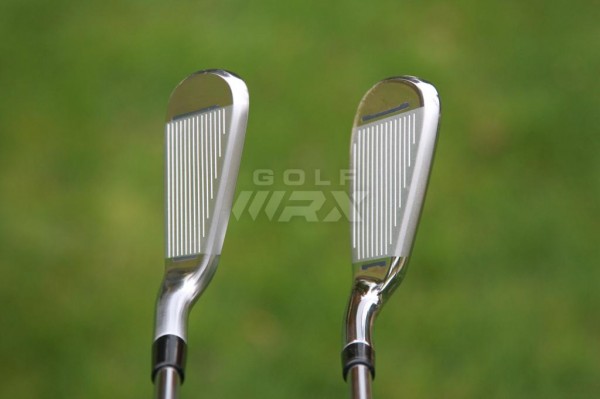
Above: TaylorMade’s RSi 2 (left) and RSi 1. Both clubs are 7 irons.
The RSi 2’s have the same general shape of the SLDR irons and sit between the RSi 1 and RSi TP irons when it comes to size. The toplines and soles are smaller than the RSi 1 and will appeal to the better player. I love how these sit behind the ball at address. There is some mass to these irons, but I never had the feeling that I wasn’t in complete control over the face. The larger long irons and smaller short irons is exactly what I want to see in an iron set like these.
Getting past the sexiness of these clubs, I’m straight up in love with the feel. The forged face inserts of the 8-PW are so soft that if I hit shots blindfolded (and actually hit the ball) I wouldn’t be able to tell the entire head wasn’t forged. But every club, all the way down to the 3 iron, has a soft, responsive feel with an incredible amount of feedback. On the range or even the course, I knew exactly where I made contact. Pure, flushed shots felt even better than the SLDR, which I also really like, and the new sound dampening of the irons produced a really striking sound at impact.
That all said, I’m disappointed in the grip choice. The stock TaylorMade Lamkin just doesn’t cut it with such a solid, premium set. There are a couple other custom options available at no extra charge, but I would’ve been happier to see at least the same Golf Pride Tour Velvet come stock just as with the SLDR. I’ll be regripping these clubs for sure.
The RSi 1 irons, while following a similar design package, are the sporty twin to the RSi 2’s preppy look. The bold red and black colors, graphics on the grip and bright polished chrome give these a more typical game-improvement iron look which is instantly recognizable as a TaylorMade product. There isn’t as much refinement to the cast, and while I prefer a more classic look, these are still a good looking iron.
When I asked my playing partners to take a swing with the RSi 1 7 iron, everyone agreed that the larger head and more mass was confidence-inspiring at address. But they didn’t feel like the iron was too big or that they would just “be along for the ride” as with some of the larger irons on the market today. I felt the same way all the way through the set.
The feel of the RSi 1 didn’t quite suit my tastes. While still very nice and responsive, they had a more typical cast feel through the set. For higher handicap golfer however, these likely will feel great. There is still a softness to them and you get feedback on mishits, but that feedback is somewhat masked. For some, that will be just fine as long as the ball flies straight toward the green.
The Takeaway
The RSi 1 and RSi 2 irons, with the new face slots, deliver great performance. While I didn’t see a massive difference in forgiveness between the RSi 2 and the SLDR irons, the consistency on mishits all over the face is evident in the numbers, but more importantly, evident on the actual course.
The soft, responsive feel, crisp sound and performance will be appreciated by better players and the RSi 2 irons will likely be one of the best performing irons of the coming year in their category.
The RSi 1 irons, also with the new face slots and a slightly larger more forgiving head, will help higher handicap golfers hit more consistent shots when they miss the middle of the club face. This means more greens in regulation and better scores.
As with any new club purchase, you should stop by a local golf shop and hit these for yourself. Both the RSi 1 and RSi 2 should definitely be at the top of the list of clubs to test this year and the RSi 2 irons are going in my bag.
Click here to see what GolfWRX Members are saying about the irons in our forum.
